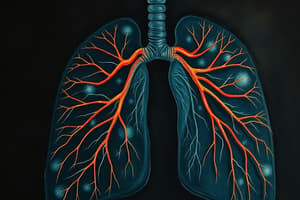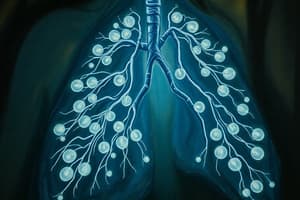Podcast
Questions and Answers
What roles do leukocytes, macrophages, and mast cells play in the respiratory system?
What roles do leukocytes, macrophages, and mast cells play in the respiratory system?
- They are involved in the production of surfactant
- They are part of the immune defense mechanism (correct)
- They regulate body temperature
- They assist in the filtration of blood
During expiration, what substances are expelled from the body?
During expiration, what substances are expelled from the body?
- Hydrogen and bicarbonate
- Nitrogen and oxygen
- Carbon dioxide and nutrients
- Water and heat (correct)
How do the lungs help maintain acid-base balance in the body?
How do the lungs help maintain acid-base balance in the body?
- By regulating blood oxygen levels
- By releasing surfactant into the bloodstream
- By increasing hydrogen ion concentration
- By controlling carbon dioxide elimination (correct)
What is the role of Type II pneumocytes in the lungs?
What is the role of Type II pneumocytes in the lungs?
Which process describes the mechanism of carbon dioxide conversion in the blood?
Which process describes the mechanism of carbon dioxide conversion in the blood?
Which secondary function is NOT associated with the respiratory system?
Which secondary function is NOT associated with the respiratory system?
What is the significance of the cough and sneezing reflexes in the respiratory system?
What is the significance of the cough and sneezing reflexes in the respiratory system?
What substance does the respiratory tract secrete for heat regulation?
What substance does the respiratory tract secrete for heat regulation?
What is the primary function of external respiration?
What is the primary function of external respiration?
Which part of the respiratory system includes the bronchi, bronchioles, and terminal bronchioles?
Which part of the respiratory system includes the bronchi, bronchioles, and terminal bronchioles?
What is the average respiratory rate for infants and neonates?
What is the average respiratory rate for infants and neonates?
The space inside the alveolar sac is referred to as what?
The space inside the alveolar sac is referred to as what?
How many times does the airways typically divide before reaching the alveolar sacs?
How many times does the airways typically divide before reaching the alveolar sacs?
What type of cells line each alveolus?
What type of cells line each alveolus?
What is the main purpose of pulmonary ventilation?
What is the main purpose of pulmonary ventilation?
What is the function of the respiratory muscles?
What is the function of the respiratory muscles?
What are the primary roles of the respiratory system?
What are the primary roles of the respiratory system?
Which cells are primarily responsible for gas exchange in the alveoli?
Which cells are primarily responsible for gas exchange in the alveoli?
What substance is secreted by Type II cells in the alveoli?
What substance is secreted by Type II cells in the alveoli?
What is the total surface area of the alveolar walls in contact with capillaries?
What is the total surface area of the alveolar walls in contact with capillaries?
What role do mast cells play in the respiratory system?
What role do mast cells play in the respiratory system?
Which of the following is NOT a non-respiratory function of the respiratory tract?
Which of the following is NOT a non-respiratory function of the respiratory tract?
How do respiratory bronchioles contribute to gas exchange?
How do respiratory bronchioles contribute to gas exchange?
What is the primary role of pulmonary alveolar macrophages (PAMs)?
What is the primary role of pulmonary alveolar macrophages (PAMs)?
Flashcards
External Respiration
External Respiration
The process of O2 absorption and CO2 removal from the body as a whole.
Internal Respiration
Internal Respiration
Utilized O2 and CO2 production by cells and exchanges between cells and their fluid medium
Pulmonary Ventilation
Pulmonary Ventilation
The mechanical process of breathing (inspiration, expiration, pause).
Pulmonary Gas Exchange
Pulmonary Gas Exchange
Signup and view all the flashcards
Respiratory Zone
Respiratory Zone
Signup and view all the flashcards
Respiratory Unit
Respiratory Unit
Signup and view all the flashcards
Conducting Zone
Conducting Zone
Signup and view all the flashcards
Alveoli
Alveoli
Signup and view all the flashcards
Respiratory Zone
Respiratory Zone
Signup and view all the flashcards
Type I Alveolar Cells
Type I Alveolar Cells
Signup and view all the flashcards
Respiratory rate
Respiratory rate
Signup and view all the flashcards
Type II Alveolar Cells
Type II Alveolar Cells
Signup and view all the flashcards
Pulmonary Capillaries
Pulmonary Capillaries
Signup and view all the flashcards
Gas Exchange
Gas Exchange
Signup and view all the flashcards
Surfactant
Surfactant
Signup and view all the flashcards
Respiratory Zone Airways
Respiratory Zone Airways
Signup and view all the flashcards
Respiratory Defense Mechanisms
Respiratory Defense Mechanisms
Signup and view all the flashcards
Respiratory Tract Cell Types
Respiratory Tract Cell Types
Signup and view all the flashcards
Water Balance in Respiration
Water Balance in Respiration
Signup and view all the flashcards
Heat Regulation in Respiration
Heat Regulation in Respiration
Signup and view all the flashcards
Acid-Base Balance in Lungs
Acid-Base Balance in Lungs
Signup and view all the flashcards
Metabolic Activity & CO2
Metabolic Activity & CO2
Signup and view all the flashcards
Other Respiratory Functions
Other Respiratory Functions
Signup and view all the flashcards
Surfactant Secretion
Surfactant Secretion
Signup and view all the flashcards
Study Notes
Respiratory System Overview
- Respiration is the process of supplying tissue cells with oxygen and eliminating CO2
- Oxygen consumption in a young adult is 250 ml/minute
- Carbon dioxide production is roughly 200 ml/minute
- Respiration includes three processes
- External respiration: absorption of oxygen and removal of CO2 from the body
- Transport of oxygen and carbon dioxide
- Internal respiration: utilization of oxygen and production of CO2 by cells, and gaseous exchange between cells and their fluid
- External (pulmonary) respiration includes two processes:
- Pulmonary ventilation: respiratory rate (12-16 breaths per minute in adults, 40 breaths per minute in infants and neonates), inspiration, expiration, and expiratory pause
- Pulmonary gas exchange: oxygen diffuses from alveolar air to pulmonary capillaries, and CO2 diffuses in the opposite direction
- The respiratory system consists of:
- Respiratory tract (airways or passages)
- Thoracic cage and respiratory muscles
- Nerve centers controlling respiration
- Respiratory unit components:
- Respiratory bronchioles
- Alveolar ducts
- Alveolar sacs
- Antrum
- Alveoli
- Alveolus characteristics:
- Pouch-like structure
- Diameter of approximately 0.2 to 0.5 mm
- Lined with epithelial cells
- Structure of respiratory system: conducting zone, transition zone, respiratory zone
Function of the Respiratory System
- Primary Functions
- Provides oxygen for tissue metabolism
- Removes carbon dioxide, a metabolic waste product.
- Secondary Functions
- Facilitates the sense of smell
- Produces speech.
- Aids in regulating acid-base balance
- Maintains body water level
- Regulates body temperature
- Protects against inhaled pathogens and irritants
- During expiration, besides water loss, heat is also lost.
- In the lungs, carbon dioxide is removed from the blood into the alveoli. Increased metabolic activity leads to more carbon dioxide production, resulting in acidosis.
- Breathing movements support venous return and lymph flow.
- Pulmonary capillaries filter venous blood to prevent emboli.
- Metabolic & Endocrine Functions:
- Type II pneumocytes secrete surfactant.
- Lungs remove substances from the blood (e.g., serotonin, bradykinin, acetylcholine, norepinephrine).
- Secretion of heparin from mast cells.
- Angiotensin I conversion to Angiotensin II by ACE
- Fibrinolysis
- Secretion of VIP (vasoactive intestinal polypeptide) which relaxes the bronchial tree.
Respiratory Tract Anatomy
- The inspired air travels to the alveoli via nasal passages, pharynx, trachea, bronchioles, and alveolar ducts.
- Airways divide approximately 23 times between the trachea and the alveolar sacs.
- The first 16 generations form the conducting zone, transporting gas to and from the body exterior, consisting of bronchi, bronchioles, and terminal bronchioles.
- The remaining seven generations form the transitional and respiratory zones, where gas exchange occurs; respiratory bronchioles, alveolar ducts, and alveoli.
Structures of Respiratory Zone/ Airway
- Alveoli are lined by two types of epithelial cells:
- Type I cells: thin, flat cells with extensions, enabling gas exchange
- Type II cells: thicker, containing lamellar bodies which secrete surfactant
- Total surface area of 300 million alveoli is approximately 70 m2
- Total surface area is 70-80 m2
- There are about 300 million alveoli in both lungs, providing extensive surface area for gas exchange.
- Alveolar walls and capillaries are separated by a thin layer of tissue, promoting efficient gas exchange, with a separation of 0.5µm.
Other Special Respiratory Cells
- Special types of epithelial cells like pulmonary alveolar macrophages (PAMs), lymphocytes, plasma cells, APUD cells and mast cells are present in the lungs.
- Mast cells contain heparin, various lipids, histamine and various proteases, which are involved in allergic reactions.
Defense Mechanisms- Prevention of Dust Particles
- Dust particles entering the nostrils are prevented from reaching the lungs through filtration by hairs in the nasal mucous membrane.
- Small particles are trapped by the nasal mucous membrane, and those escaping are removed by the phagocytic action of macrophages in the alveoli.
- Particles escaping these defenses are expelled through cough or sneeze reflexes.
Studying That Suits You
Use AI to generate personalized quizzes and flashcards to suit your learning preferences.
Related Documents
Description
Explore the fundamental processes of respiration, including external and internal respiration, and understand how oxygen and carbon dioxide are exchanged in the body. This quiz covers the basic mechanics of pulmonary ventilation and gas exchange, providing insights into the functioning of the respiratory system.




